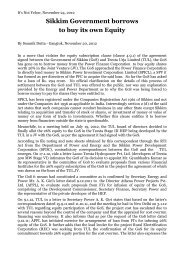Socio-Cultural Environment - Affected Citizens of Teesta (ACT)
Socio-Cultural Environment - Affected Citizens of Teesta (ACT)
Socio-Cultural Environment - Affected Citizens of Teesta (ACT)
You also want an ePaper? Increase the reach of your titles
YUMPU automatically turns print PDFs into web optimized ePapers that Google loves.
demographic as well as socio-economic situations in Sikkim. For the<br />
purpose, more than three months were spent in the field at different<br />
phases. The work involved intensive field investigation, collection and<br />
analysis <strong>of</strong> primary data. A detailed interview schedule consisting <strong>of</strong><br />
about a hundred open as well as close-ended questions was structured<br />
to obtain maximum possible information. About 50 villages within 10 km<br />
on either side <strong>of</strong> the river <strong>Teesta</strong> were visited and 150 individuals were<br />
interviewed. The sampling was purposive and only key informants were<br />
selected for interview. For almost every village, at least one Panchayat<br />
member was interrogated. The other respondents were selected from a<br />
wide range <strong>of</strong> income groups covering the primary, secondary and<br />
tertiary sectors. Given the fact that Sikkim is home <strong>of</strong> various ethnic<br />
groups, particular attention was paid in selecting respondents with<br />
different ethnic and cultural backgrounds. A cross section <strong>of</strong> Lepchas,<br />
Bhutias, Nepalese and Plainsmen in age groups ranging from 21 to 75<br />
was interviewed. Besides, a deliberate attempt was made to avoid<br />
gender bias. More than 25% <strong>of</strong> the respondents were female.<br />
Most <strong>of</strong> the secondary data were collected from the Directorate <strong>of</strong><br />
Economics, Statistics, Monitoring and Evaluation, Government <strong>of</strong> Sikkim<br />
and Directorate <strong>of</strong> Census Operations, Sikkim Branch, Government <strong>of</strong><br />
India. Besides, relevant data and information were collected from the<br />
Departments <strong>of</strong> Mines and Geology, Forests, Agriculture and<br />
Horticulture, Rural Development, Tourism and Culture, Government <strong>of</strong><br />
Sikkim. For useful references, books and journals available at the<br />
Documentation Centre <strong>of</strong> the Centre for Himalayan Studies, North<br />
Bengal University, Central Library <strong>of</strong> North Bengal University,<br />
Community Centre Library, Gangtok, Library <strong>of</strong> the Namgyal Institute <strong>of</strong><br />
Tibetology, Gangtok, etc. were consulted.<br />
6<br />
CISMHE




